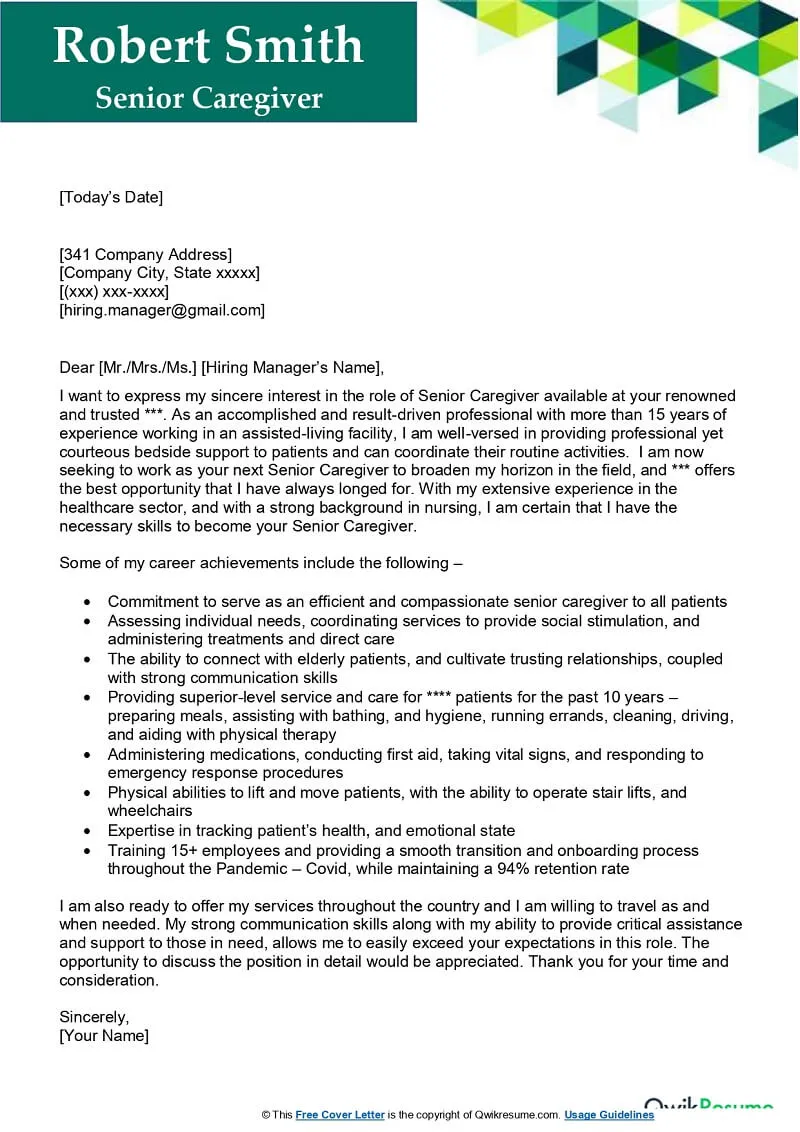Highlighting Your Skills in Caregiver Cover Letter
A caregiver cover letter is your first impression. It’s the initial point of contact with a potential employer, and it needs to showcase your abilities effectively. Start by identifying the key skills that align with the job description. These might include experience in medication management, meal preparation, personal care, and companionship. Quantify your achievements whenever possible, for example, ‘Assisted with medication schedules for five patients’ or ‘Prepared three nutritious meals daily for residents.’ This immediately communicates the value you bring. Beyond listing skills, give examples of how you’ve used them to help others. Focus on how your skills have made a positive impact on the individuals you’ve cared for. Were you able to improve their quality of life, ensure their safety, or enhance their independence? A well-crafted skills section can set you apart and highlight what makes you a strong candidate.
Detailing Relevant Experience in Caregiver Cover Letter
Experience is crucial in the caregiver field, so clearly describe your previous roles. Instead of just listing job titles and dates, expand on the responsibilities and accomplishments from each role. Elaborate on the specific tasks you performed, the population you served (e.g., elderly, individuals with disabilities, those recovering from surgery), and the environments you worked in (e.g., private homes, assisted living facilities, hospitals). Providing context gives the employer a comprehensive understanding of your skills. Did you manage complex medical needs, such as wound care or diabetes management? Did you provide emotional support and companionship? Highlighting these aspects of your experience demonstrates your suitability for the position. Use action verbs to describe your duties: ‘Administered,’ ‘Assisted,’ ‘Monitored,’ ‘Provided,’ and ‘Maintained.’
Showcasing Compassion & Empathy
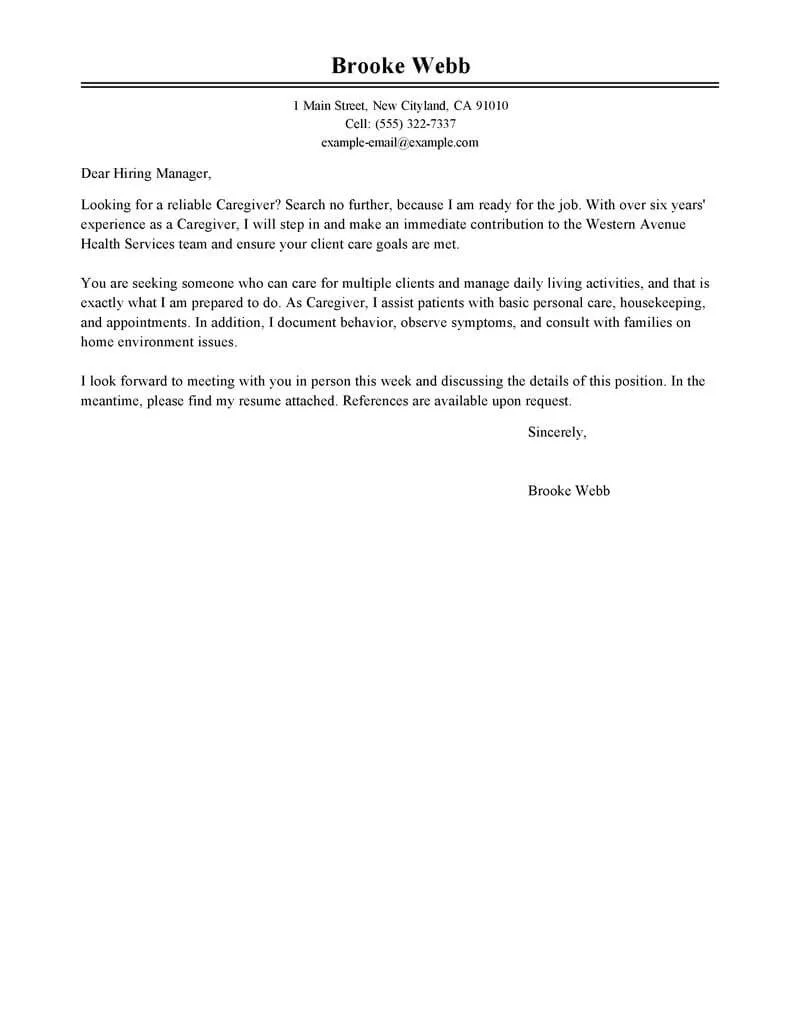
Caregiving is more than just a job; it requires a deep understanding and genuine empathy for the individuals you care for. Your cover letter should reflect your ability to connect with people and show a compassionate nature. Express your passion for helping others and improving their quality of life. This can be achieved by highlighting your approach to providing care, such as fostering a supportive and encouraging environment, being patient and understanding, and respecting the dignity of each individual. Examples can be included, for instance, if you have experience helping patients through difficult times or providing emotional support to their families, mention those to illustrate your compassion. Be authentic and let your genuine care shine through. It is important to demonstrate that you are not just skilled but that you also care about the well-being of your patients.
Tailoring Your Letter to the Job
A generic cover letter will not make the impact of a tailored letter. Take the time to customize your cover letter for each specific job application. Carefully read the job description and identify the most important requirements and skills. Then, make sure to highlight in your letter how your qualifications and experience match those needs. This shows the employer that you’ve put in the effort to understand the role and are serious about the opportunity. Use the same keywords and phrases that appear in the job description. By using this technique, you increase your chances of passing the initial screening processes. Avoid simply repeating the job description. Instead, provide specific examples of how you’ve demonstrated these skills and experiences in the past. Customize your letter to focus on specific roles and requirements.
Researching the Employer
Before you start writing your caregiver cover letter, it’s essential to do some research on the employer. Understanding the organization’s values, mission, and the type of care they provide will help you tailor your letter effectively. Visit the company’s website to gather information about their services, patient demographics, and the culture of their workplace. If the employer is a care facility, learn about their specific approach to patient care. If it’s a private home, try to find out as much as possible about the individual or family you will be caring for. This research allows you to address the employer’s unique needs and demonstrate your genuine interest in the position. You can highlight in your cover letter that your values align with the organization. This demonstrates that you are not just looking for a job, but that you are also a great fit for their team.
Understanding the Specific Needs
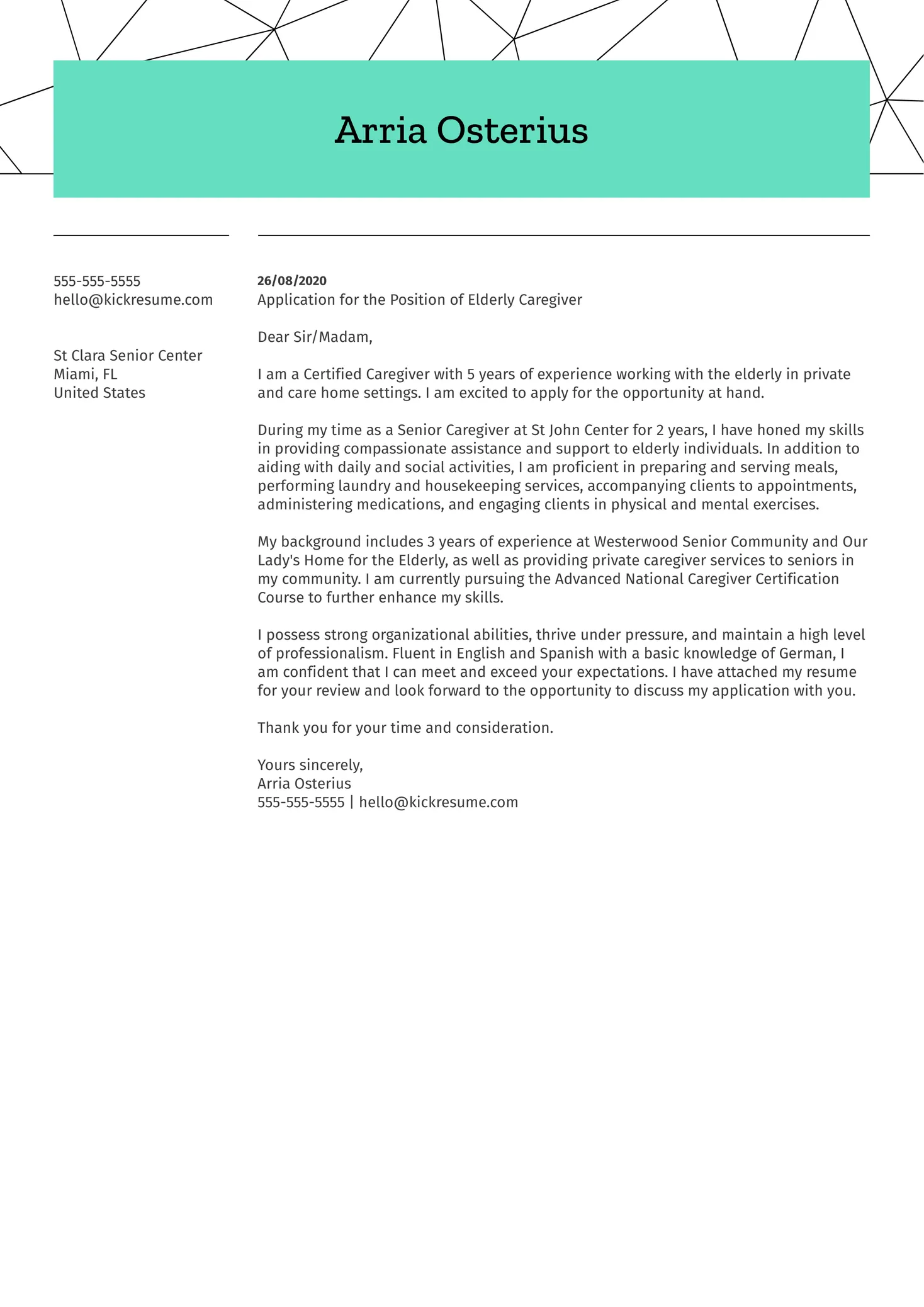
Every caregiving role is unique. Whether it’s in a private home, an assisted living facility, or a hospital, the requirements of the job will vary. In your cover letter, address the specific needs of the person or people you will be caring for. If the job description specifies particular conditions, such as dementia, mobility issues, or medication needs, make sure to highlight relevant experience. For example, if the role involves assisting with mobility, mention your experience with transferring patients. If it involves managing medications, specify your training and experience in this area. When mentioning special needs or conditions, emphasize your ability to provide compassionate and tailored care. By focusing on the specifics, you can quickly show the employer that you’re the right person for the job. You can easily address specific requirements by demonstrating that you understand and are prepared to address them.
Formatting for Success
A well-formatted cover letter can be the difference between getting the job or getting ignored. Ensure your cover letter is well-organized and easy to read. Use a professional font like Arial, Calibri, or Times New Roman and keep the font size between 10 and 12 points. Begin with your contact information at the top, including your name, address, phone number, and email address. Follow this with the date and the employer’s contact information. The body of your letter should be concise and divided into clear paragraphs. Use headings to separate sections, making it easy for the hiring manager to scan and find the information. Pay attention to the spacing between paragraphs and sections for optimal readability. Maintain a professional tone throughout your letter. Avoid slang or casual language and maintain a professional format to create a good impression.
Professional and Clear Language
The language you use in your caregiver cover letter is crucial. Always maintain a professional and respectful tone. Use clear, concise language that effectively communicates your skills and experience. Avoid overly technical jargon and write in a way that is easy for anyone to understand, as you are looking for a job. Avoid using overly casual or informal language, such as slang or contractions. Instead, use formal language that showcases your respect and professionalism. Proofread your letter carefully to catch any grammatical errors or typos. Check the formatting and ensure that your letter is neat and easy to read. To communicate effectively, use strong action verbs to describe your responsibilities and accomplishments. Your writing will set you apart from the rest of the applicants.
Proofreading and Editing
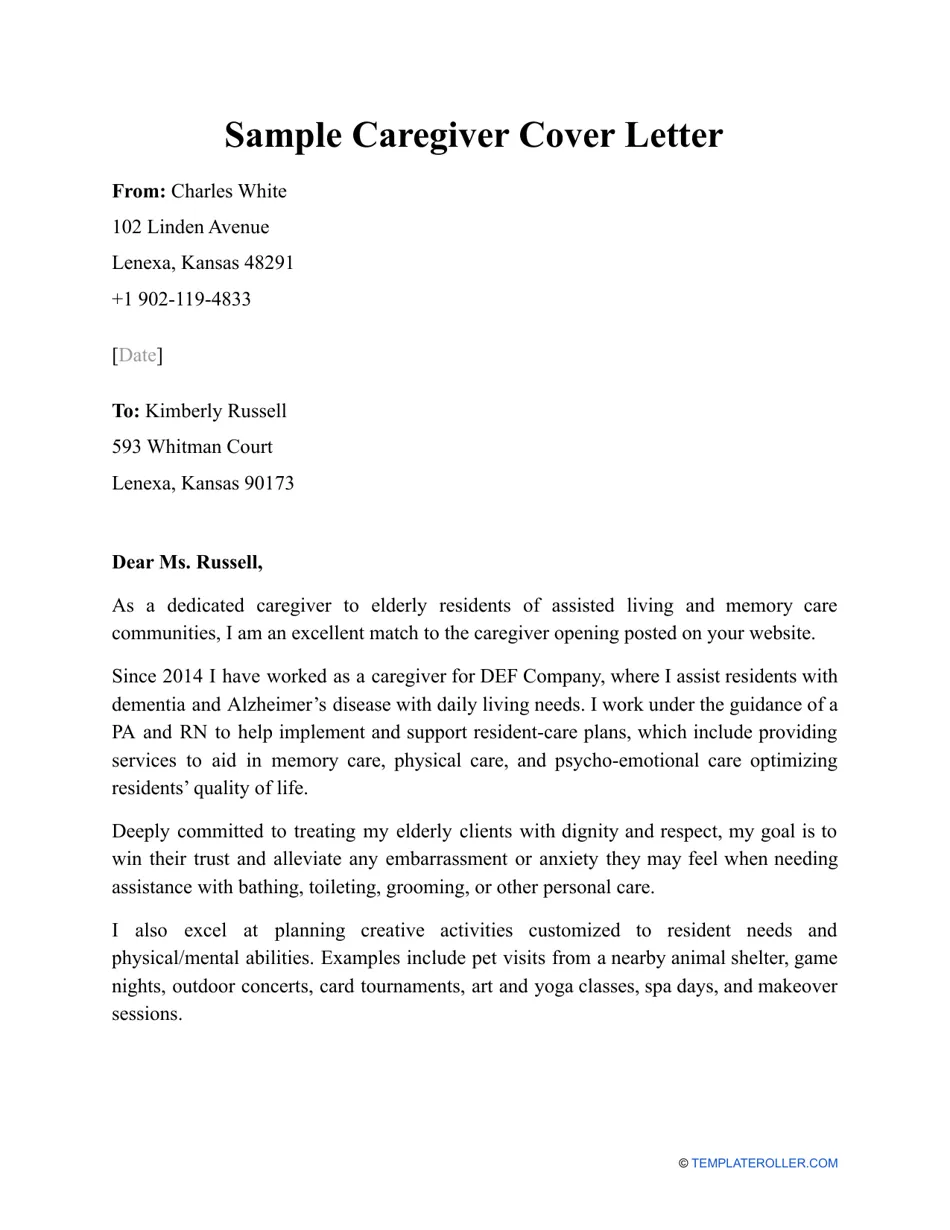
Before you submit your cover letter, it’s essential to proofread and edit it thoroughly. Errors in grammar, spelling, and punctuation can undermine your professionalism and credibility. Always take the time to read your letter carefully. Look for any typos, grammatical errors, or awkward phrasing. You can also use an online tool, such as Grammarly or ProWritingAid, to help identify errors and improve your writing. It’s helpful to have another person review your letter for you, as an extra set of eyes can catch mistakes you might have missed. Ask a friend, family member, or career counselor to read your cover letter and provide feedback on clarity, grammar, and overall effectiveness. Reviewing and editing your letter is a critical step to ensure your cover letter presents you in the best possible way.
Checking for Grammar & Spelling
Incorrect grammar and spelling can quickly damage your chances of getting hired. Before submitting your cover letter, review it meticulously for any errors. Pay close attention to subject-verb agreement, correct tense usage, and punctuation. Ensure all words are correctly spelled. Use a spellchecker and grammar checker to help identify errors, but do not rely on these tools alone. They can sometimes miss subtle errors. Read your cover letter aloud to ensure that the language flows smoothly and that your message is clear. Ensure the accuracy of the information. A cover letter that is free of errors shows attention to detail, which is an essential quality for a caregiver. Taking this extra step will show the potential employer you are serious about the job and the application process.
Call to Action for Caregiver Cover Letter
A strong call to action at the end of your cover letter encourages the employer to take the next step. After highlighting your skills and experience, you want to express your enthusiasm for the position and your desire to move forward. Include a clear statement indicating your interest in an interview. State your availability for an interview and provide your contact information again. Make sure your call to action is clear, concise, and confident. For example, you can write ‘I am eager to learn more about this opportunity and discuss how my skills can benefit your team. I am available for an interview at your earliest convenience. Please contact me at [Phone Number] or [Email Address].’ By making it easy for the employer to respond, you increase the likelihood of getting an interview.
Expressing Enthusiasm and Availability
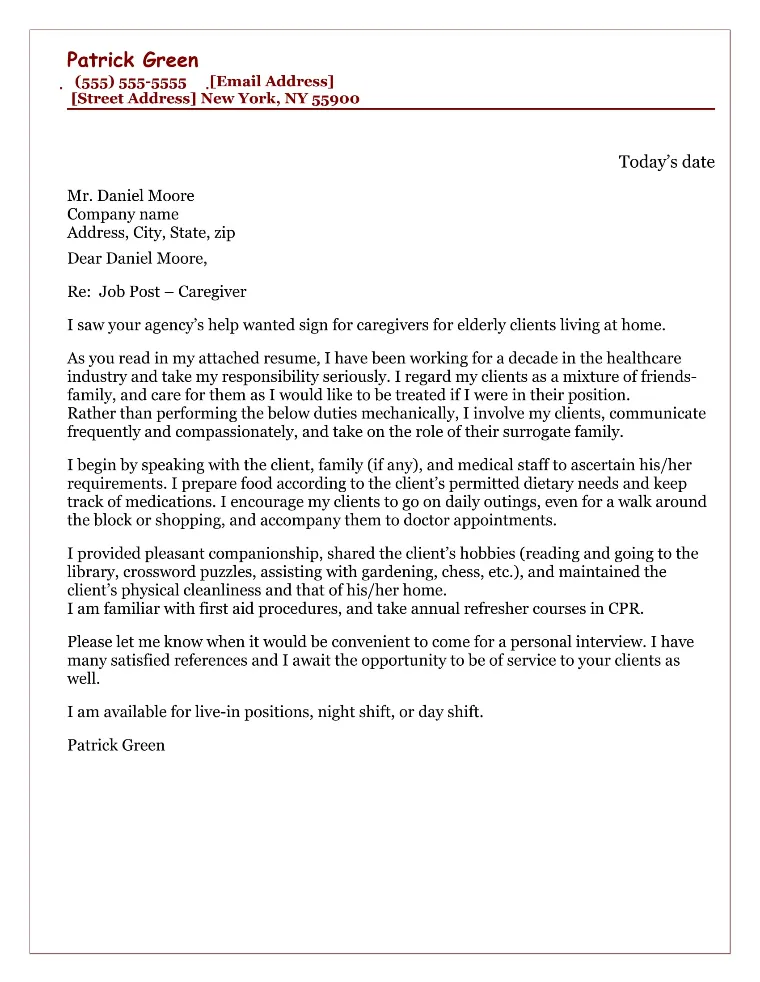
Your cover letter should convey your enthusiasm for the role and make it clear that you are interested in the position. Express your excitement about the opportunity to work for the employer, especially if you have researched the company and understand their values. Let the employer know that you are available for an interview. Provide details about your schedule to ensure you are available at their convenience. You can mention your flexibility and willingness to work different shifts. It is important to be specific about your availability to show your willingness to commit to the role. Make sure your enthusiasm is genuine, as this can make you a more appealing candidate.
Providing Contact Information
Make it very easy for employers to contact you by providing your contact information clearly and concisely. At the top of your cover letter, list your full name, address, phone number, and email address. Repeat this information at the end of your letter, just before your signature. Ensure your contact information is accurate and up-to-date. Double-check your email address and phone number to prevent any errors. Your contact details should be professional and reliable. Using your phone number and email address ensures that the employer can easily reach you. By providing your contact details, you make it easy for the employer to contact you and move forward with the application process.
